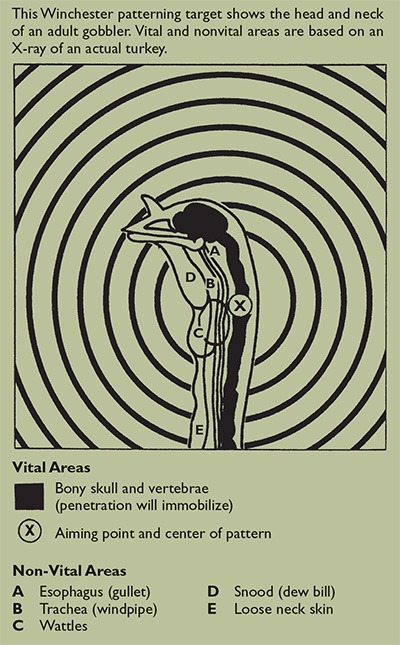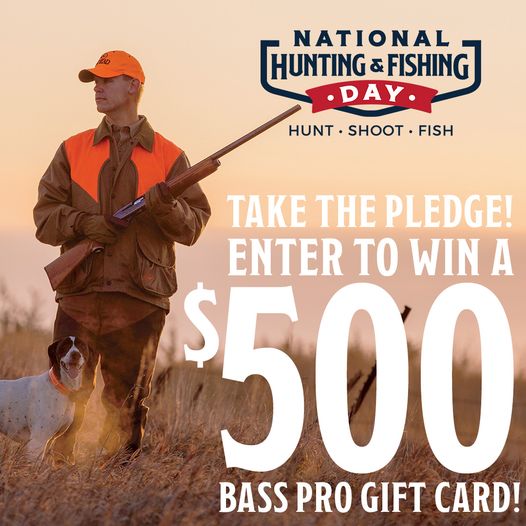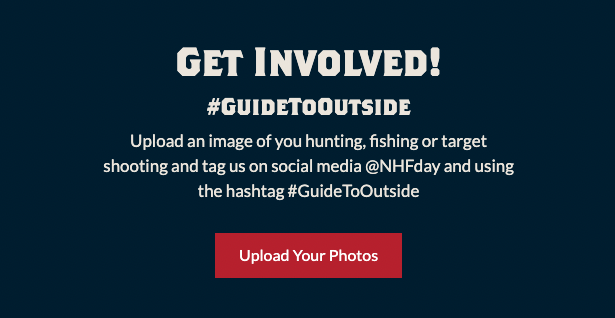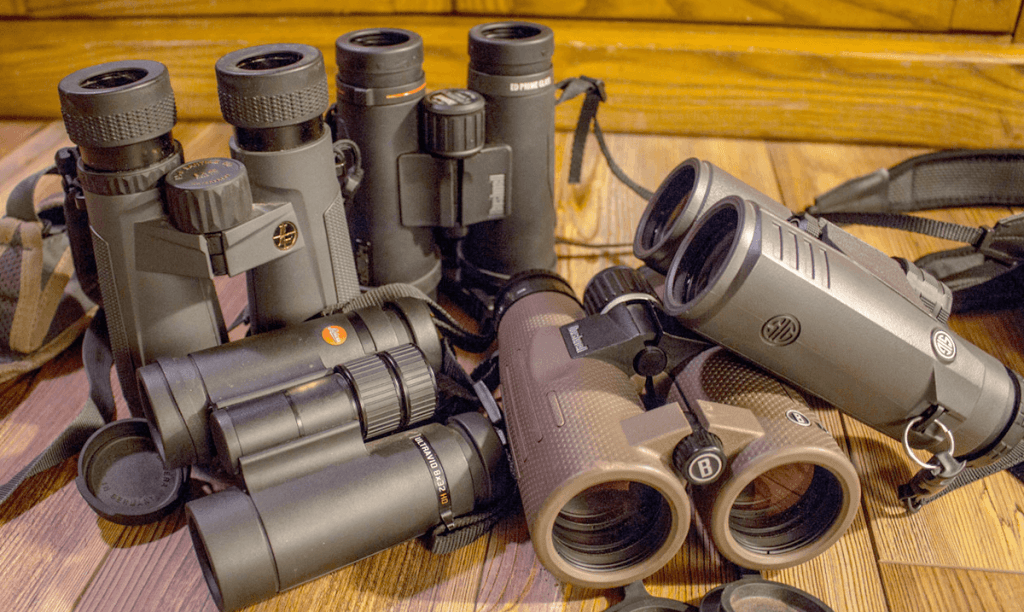
Shopping for a New Binocular
By Phil Massaro
A binocular is one of those tools that end up proving to be nearly invaluable. From checking distant targets for a fellow shooter to scouting for deer in the early autumn and bird watching, a binocular allows you to see more and see better. There’s a lot to choose from in the world of enhanced vision, including magnification ranges, lens size, additional features and (usually the most important factor) price. Let’s take a look at what the differences are, and which type of binocular is right for you.
Magnification Range
You will need to assess your specific glassing needs in order to make a proper decision when it comes to the magnification range of your binocular. Many people believe that more magnification is better, but that’s not always the case. For instance, field of view, the width of the image seen through the binocular, can in fact be too narrow when using higher magnification binoculars. I personally prefer a high-quality design of lower magnification than the reverse. The finest brands will give a bright, crisp image at 8X magnification, where the poorly made models (some with very attractive price tags) will struggle to compete at any magnification level.
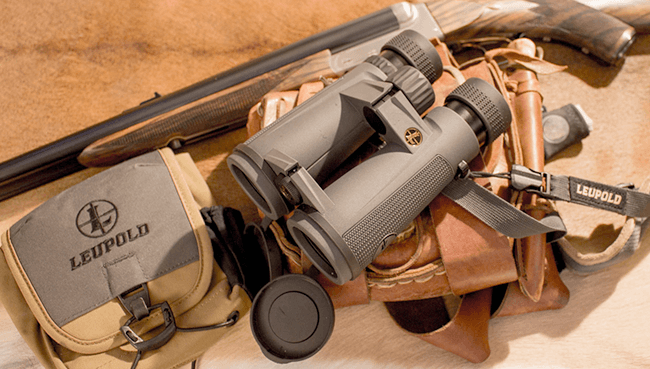
The Leupold BX-5 Santiam HD, one of the author’s favorite binoculars. It represents an excellent value, giving premium performance at a very attractive price.
Higher magnification levels do have their place, especially for glassing across canyons or open plains or tundra. Still, you’ll have to balance their benefit there against their generally larger, heavier bodies and more expensive price tags.
Binoculars are labeled with the magnification level first, the diameter of the objective lens (in millimeters) second. Thus, a 10×32 binocular has 10X magnification and 32mm lenses. General-purpose binoculars usually have 7X, 8X or 10X magnification and 32 to 40mm lenses. I have owned smaller models—I had a Zeiss 8×20 “shirt-pocket” model that worked well for deer hunting in thicker woods—but the smaller objective lenses don’t offer the light transmission the larger models do. Contrarily, the larger models are heavier and can be more difficult to hold steady for viewing, so you can see where the tradeoffs need to be made.
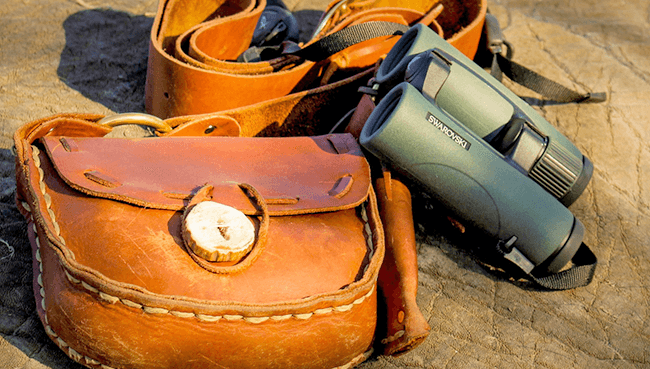
The Swarovski 8×32 EL—what may be the Holy Grail of binoculars to many hunters and shooters. It isn’t cheap, but it’s worth the investment.
The Prism Question
Modern binoculars are broken into two groups: roof-prism and Porro-prism models. Without getting deep into the physics, the Porro-prism design uses a pair of offset prisms, which usually results in a greater distance between the ocular lenses. These binoculars have a short, stout, squat look. The roof-prism binocular uses a pair of back-to-back prisms, and the straight-line design allows for a more compact design. With a hinge in the center, the unit looks much like a capital “H.”
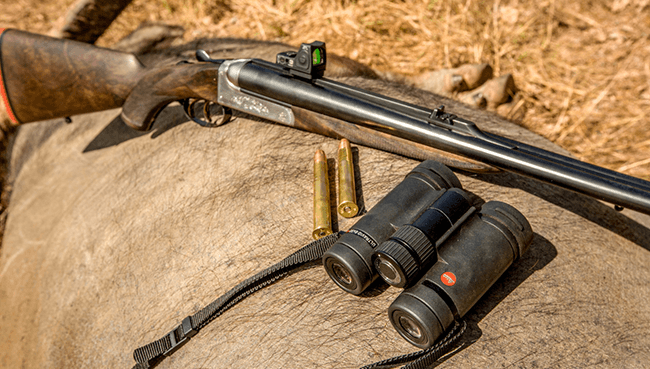
The author’s Leica Ultravid 8×32 HD binocular, shown here in Australia, has been on many different hunts and has always been reliable.
I tend to lean toward roof-prism designs, as I most often carry my binocular on a strap, hanging under my left arm, and that shape works best for that kind of transport. Several friends prefer to carry their binocular in a harness, with the binocular sitting on the middle of the chest. This allows for a fast, two-handed grip that quickly raises the unit to the eyes, something well-suited to the Porro prism.
Lenses, Coatings and Price Range
You’ll find a wide price range, when it comes to binoculars. Tags ranges from about $100 for an entry-level model up to and over $4,000 for a fine European binocular loaded with features. To find what is going to work best for you will require a shopping trip in order to compare makes and models.
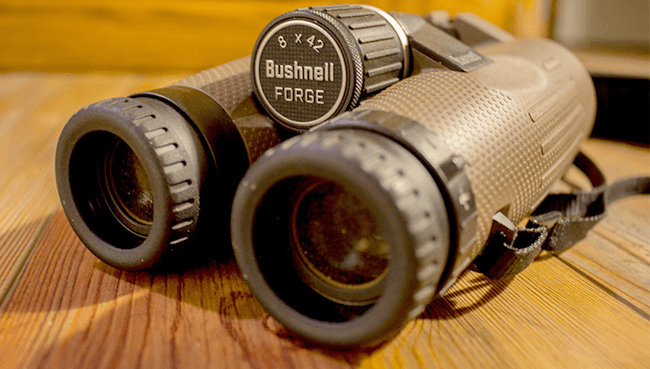
This 8×42 Bushnell Forge binocular gives the user a lot of features— coated lenses, EXO Barrier protection to protect the glass from the elements, etc.— for the investment. The author has taken it on safari to Africa, as well as numerous hunts across North America.
My choices generally lie in the middle to lower end of that price range, though I understand why a professional hunter or registered guide—those whose livings depend on seeing game animals—would invest a healthy sum of money in the best binocular they could afford. If you hunt with enough guides, you’ll invariably see a well-worn Swarovski, Zeiss, or Leica binocular on the dashboard of the truck. Bird watchers, too, are devotees of fine glass and target shooters, especially those working at long range, appreciate glass that lets them see mirage and waving grasses far away. There are few rivals the lens quality of those renowned glass makers, though some of our American manufacturers come close.
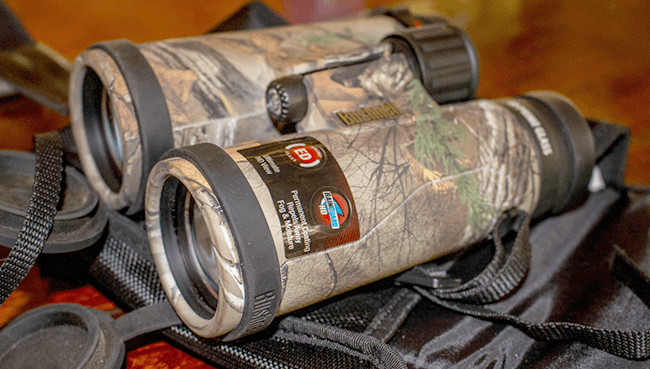
An entry-level binocular like this Bushnell Legend 10×42 can serve a hunter well. Such optics on the lower end of the price spectrum have come a long way in recent years.
Some binoculars give more than just magnified vision. A number of models, for instance, have built-in rangefinders, while others offer thermal imaging. Such additional options certainly raise the price of the unit, as well as add to the weight. If these options appeal to you, so be it, just realize they change the game a bit.
As an outdoor writer, I use more than one brand throughout the year, and I can say that a number of lower-priced binocular brands have greatly improved in quality over the decades. I’ve used several Bushnell binoculars, which represent a great value, and I can say the same for Vortex and Nikon.
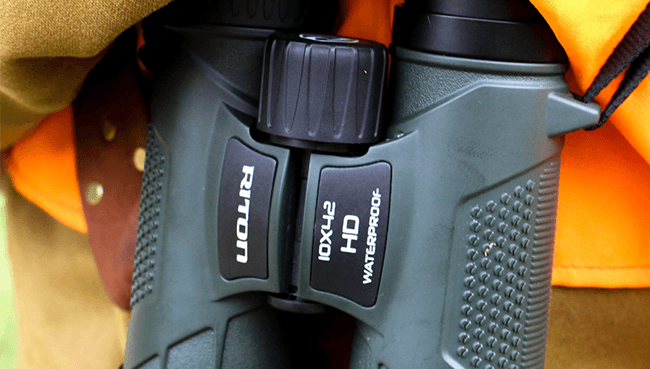
Some of the lesser-known companies such as Riton Optics produce a useable and reliable binocular, but you’ll have to spend some time shopping around for them.
Still, not all binoculars are created equal, and that said, lens quality and coatings are of utmost importance when deciding between models and prices. Cheap lenses cause eye strain. Cheap construction won’t stand up to rigorous use in the field; I like adjustable eye cups that stay where I put them, just as I do the focal knobs. I also want a crisp, clear image with plenty of contrast, and lens coatings that help shift the color spectrum so I can pick game animals out of the brush in low-light conditions. Among the models I’ve used over the years that have excellent lenses and coatings, I’ve most enjoyed Leupold’s 10×42 BX-5 Santium HD, Swarovski’s 8×32 EL and Leica’s Ultravid 8x32HD as great all-around-use choices. They have worked well for me across four continents and in a number of different conditions and environments from sub-zero weather in Canada to hotter-than-hell-itself in Zimbabwe.
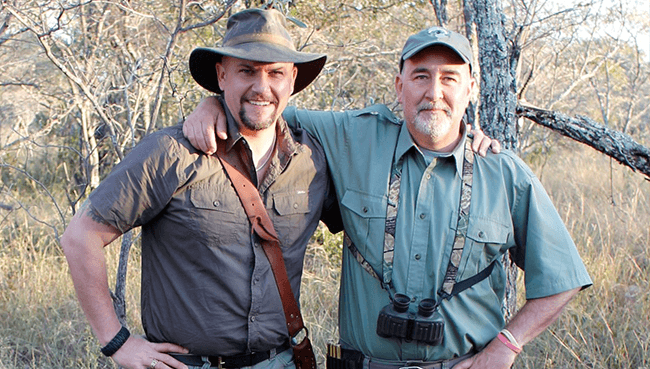
The author (left) and safari partner Dave deMoulpied. Note Dave’s Steiner Porro prism-design binocular on a chest harness.
Different brands and models provide these features to varying degrees, so when you’re shopping, do your best to sample them outdoors. Looking through a binocular under the fluorescent lighting of a sporting goods store will not give an accurate representation of light transmission or image color. Beyond that, read the reviews, try your buddy’s binocular, ask questions and look at as many different brands and models as possible. With that work, you’ll soon find a model that suits your situation makes your investment in this optic worthwhile.
About the Author
Philip Massaro is a freelance writer whose passions include big-game hunting and ballistics. He has appeared on numerous outdoor television programs and has authored books on both hunting and ballistics.
In this video, Former Army Ranger sniper team leader Ryan Cleckner demonstrates how to properly set up your binoculars.
You can also check an interesting post on the best binoculars under 100
 Excise taxes fund wildlife research for the sustainable maintenance of healthy wildlife populations.[/caption]
The excise taxes established under the Pittman-Robertson Act have been a driving force, contributing over $16.4 billion (over $25 billion adjusted for inflation) to individual states. In this video, Peter Novotny, Deputy Chief of the Ohio Division of Wildlife, highlights how these funds, combined with hunting and fishing license dollars, fund essential wildlife research. This research enables a deeper understanding of how wildlife populations adapt to a changing environment, ultimately leading to the maintenance of healthy and sustainable populations.
Excise taxes fund wildlife research for the sustainable maintenance of healthy wildlife populations.[/caption]
The excise taxes established under the Pittman-Robertson Act have been a driving force, contributing over $16.4 billion (over $25 billion adjusted for inflation) to individual states. In this video, Peter Novotny, Deputy Chief of the Ohio Division of Wildlife, highlights how these funds, combined with hunting and fishing license dollars, fund essential wildlife research. This research enables a deeper understanding of how wildlife populations adapt to a changing environment, ultimately leading to the maintenance of healthy and sustainable populations.
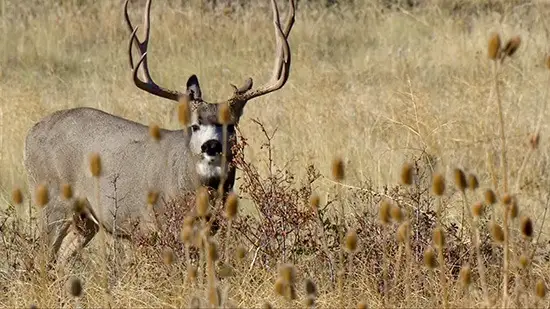 “We feel comfortable and confident that the excise tax dollars are helping keep healthy deer herds out there across the United States,” said Phil Bednar, President and CEO of TenPoint Crossbows.[/caption]
“We feel comfortable and confident that the excise tax dollars are helping keep healthy deer herds out there across the United States,” said Phil Bednar, President and CEO of TenPoint Crossbows.[/caption]
 Turkeys make a tough target. They are difficult to see and even harder to harvest. The head and neck are the only vital areas that ensure a fast, clean hunt, but this will only happen if your shotgun throws a tight, dense shot pattern.
The best shotgun choice for turkeys is a 12-gauge magnum, though the 10 gauge is gaining some ground among turkey hunters. The best shot sizes are No. 2, 4, 5, or 6. The best shotgun chokes are Full, Extra Full, and Super Full.
Turkeys make a tough target. They are difficult to see and even harder to harvest. The head and neck are the only vital areas that ensure a fast, clean hunt, but this will only happen if your shotgun throws a tight, dense shot pattern.
The best shotgun choice for turkeys is a 12-gauge magnum, though the 10 gauge is gaining some ground among turkey hunters. The best shot sizes are No. 2, 4, 5, or 6. The best shotgun chokes are Full, Extra Full, and Super Full.
